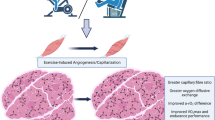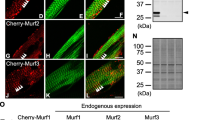Abstract
Transforming growth factor-β1 (TGF-β1) is known to be expressed in the environment of developing fast muscle fibres during ontogenesis. In the present study, we have examined effects of administration of either TGF-β1 or neutralizing TGF-β1 antibody on the induction of fast type phenotype in regenerating skeletal muscles in rats. Expressions of fast and slow myosin heavy chain (MHC) isoforms were studied using protein electrophoresis, at 3 and 6 weeks after myotoxic treatment. Muscle contractile properties were also measured in situ. The results have shown that a single injection of TGF-β1 into the regenerating slow soleus muscle increased the expression of fast MHC-2x/d and MHC-2a and decreases that of slow MHC-1 (P<0.05). Moreover, it reduced the degree of tetanic fusion during contraction (P<0.05). Conversely, injection of neutralizing antibody against TGF-β1 into the regenerating fast EDL muscle increased the expression of MHC-2a and MHC-1 (P<0.05). In conclusion, when the slow muscle was regenerating in the presence of an increased level of TGF-β1, it induced a shift to a less slow MHC phenotype and contractile characteristics. Conversely, neutralization of TGF-β1 in the regenerating fast muscle induced a shift to a less fast MHC expression. Together these results suggest that TGF-β1 influences some aspects of fast muscle-type patterning during skeletal muscle regeneration.
Similar content being viewed by others
References
Agbulut O, Li Z, Mouly V, Butler-Browne GS, (1996). Analysis of skeletal and cardiac muscle from desmin knock-out and normal mice by high resolution separation of myosin heavy-chain isoformsBiol Cell 88: 131–135
Bren-Mattison Y, Olwin BB, (2002). Sonic hedgehog inhibits the terminal differentiation of limb myoblasts committed to the slow muscle lineageDev Biol 242: 130–148
Calvo S, Vullhorst D, Venepally P, Cheng J, Karavanova I, Buonanno A, (2001). Molecular dissection of DNA sequences and factors involved in slow muscle-specific transcriptionMol Cell Biol 21: 8490–8503
Carlson CJ, Booth FW, Gordon SE, (1999). Skeletal muscle myostatin mRNA expression is fiber-type specific and increases during hindlimb unloadingAm J Physiol 277: R601–R606
Caruelle D, Mazouzi Z, Husmann I, Delbe J, Duchesnay A, Gautron J, Martelly I, Courty J, (2004). Upregulation of HARP during in vitro myogenesis and rat soleus muscle regenerationJ Muscle Res Cell Motil 25: 45–53
Cusella-De Angelis MG, Molinari S, Le Donne A, Coletta M, Vivarelli E, Bouche M, Molinaro M, Ferrari S, Cossu G, (1994). Differential response of embryonic and fetal myoblasts to TGF beta: a possible regulatory mechanism of skeletal muscle histogenesisDevelopment 120: 925–933
d’Albis A, Couteaux R, Janmot C, Roulet A, Mira JC, (1988). Regeneration after cardiotoxin injury of innervated and denervated slow and fast muscles of mammals. Myosin isoform analysisEur J Biochem 174: 103–110
De Angelis L, Borghi S, Melchionna R, Berghella L, Baccarani-Contri M, Parise F, Ferrari S, Cossu G, (1998). Inhibition of myogenesis by transforming growth factor beta is density-dependent and related to the translocation of transcription factor MEF2 to the cytoplasmProc Natl Acad Sci USA 95: 12358–12363
Devor ST, White TP, (1996). Myosin heavy chain of immature soleus muscle grafts adapts to hyperthyroidism more than to physical activityJ Appl Physiol 80: 789–794
Duprez D, (2002). Signals regulating muscle formation in the limb during embryonic developmentInt J Dev Biol 46: 915–925
Esser K, Nelson T, Lupa-Kimball V, Blough E, (1999). The CACC box and myocyte enhancer factor-2 sites within the myosin light chain 2 slow promoter cooperate in regulating nerve-specific transcription in skeletal muscleJ Biol Chem 274: 12095–12102
Fluck M, Hoppeler H, (2003). Molecular basis of skeletal muscle plasticity – from gene to form and functionRev Physiol Biochem Pharmacol 146: 159–216
Gerrits HL, Hopman MT, Offringa C, Engelen BG, Sargeant AJ, Jones DA, Haan A, (2003). Variability in fibre properties in paralysed human quadriceps muscles and effects of trainingPflugers Arch 445: 734–740
Goetsch SC, Hawke TJ, Gallardo TD, Richardson JA, Garry DJ, (2003). Transcriptional profiling and regulation of the extracellular matrix during muscle regenerationPhysiol Genomics 14: 261–271
Grifone R, Laclef C, Spitz F, Lopez S, Demignon J, Guidotti JE, Kawakami K, Xu PX, Kelly R, Petrof BJ, Daegelen D, Concordet JP, Maire P, (2004). Six1 and Eya1 expression can reprogram adult muscle from the slow-twitch phenotype into the fast-twitch phenotypeMol Cell Biol 24: 6253–6267
Harris JB, (2003). Myotoxic phospholipases A2 and the regeneration of skeletal musclesToxicon 42: 933–945
Hughes SM, Blagden CS, Li X, Grimaldi A, (1998). The role of hedgehog proteins in vertebrate slow and fast skeletal muscle patterningActa Physiol Scand 163: S7–S10
Hughes SM, Salinas PC, (1999). Control of muscle fibre and motoneuron diversificationCurr Opin Neurobiol 9: 54–64
Hughes SM, Taylor JM, Tapscott SJ, Gurley CM, Carter WJ, Peterson CA, (1993). Selective accumulation of MyoD and myogenin mRNAs in fast and slow adult skeletal muscle is controlled by innervation and hormonesDevelopment 118: 1137–1147
Husmann I, Soulet L, Gautron J, Martelly I, Barritault D, (1996). Growth factors in skeletal muscle regenerationCytokine Growth Factor Rev 7: 249–258
Kalhovde JM, Jerkovic R, Sefland I, Cordonnier C, Calabria E, Schiaffino S, Lomo T, (2005). “Fast” and “slow” muscle fibres in hindlimb muscles of adult rats regenerate from intrinsically different satellite cellsJ Physiol 562: 847–857
Lagord C, Soulet L, Bonavaud S, Bassaglia Y, Rey C, Barlovatz-Meimon G, Gautron J, Martelly I, (1998). Differential myogenicity of satellite cells isolated from extensor digitorum longus (EDL) and soleus rat muscles revealed in vitroCell Tissue Res 291: 455–468
Lefaucheur JP, Sebille A, (1995). Muscle regeneration following injury can be modified in vivo by immune neutralization of basic fibroblast growth factor, transforming growth factor beta 1 or insulin-like growth factor IJ Neuroimmunol 57: 85–91
Li Y, Huard J, (2002). Differentiation of muscle-derived cells into myofibroblasts in injured skeletal muscleAm J Pathol 161: 895–907
McLennan IS, (1993). Localisation of transforming growth factor beta 1 in developing muscles: implications for connective tissue and fiber type pattern formationDev Dyn 197: 281–290
McLennan IS, Koishi K, (1997). Cellular localisation of transforming growth factor-beta 2 and -beta 3 (TGF-beta2, TGF-beta3) in damaged and regenerating skeletal musclesDev Dyn 208: 278–289
Murgia M, Serrano AL, Calabria E, Pallafacchina G, Lomo T, Schiaffino S, (2000). Ras is involved in nerve-activity-dependent regulation of muscle genesNat Cell Biol 2: 142–147
Noirez P, Agbulut O, Ferry A, (2000). Differential modification of myosin heavy chain expression by tenotomy in regenerating fast and slow muscles of the ratExp Physiol 85: 187–191
Pin CL, Hrycyshyn AW, Rogers KA, Rushlow WJ, Merrifield PA, (2002). Embryonic and fetal rat myoblasts form different muscle fiber types in an ectopic in vivo environmentDev Dyn 224: 253–266
Rosenblatt JD, Parry DJ, Partridge TA, (1996). Phenotype of adult mouse muscle myoblasts reflects their fiber type of originDifferentiation 60: 39–45
Sakuma K, Watanabe K, Sano M, Kitajima S, Sakamoto K, Uramoto I, Totsuka T, (2000). The adaptive response of transforming growth factor-beta 2 and -beta RII in the overloaded, regenerating and denervated muscles of ratsActa Neuropathol (Berl) 99: 177–185
Schiaffino S, Reggiani C, (1996). Molecular diversity of myofibrillar proteins: gene regulation and functional significancePhysiol Rev 76: 371–423
Serrano AL, Murgia M, Pallafacchina G, Calabria E, Coniglio P, Lomo T, Schiaffino S, (2001). Calcineurin controls nerve activity-dependent specification of slow skeletal muscle fibers but not muscle growthProc Natl Acad Sci USA 98: 13108–13113
Snoj-Cvetko E, Sketelj J, Dolenc I, Obreza S, Janmot C, d’Albis A, Erzen I, (1996). Regenerated rat fast muscle transplanted to the slow muscle bed and innervated by the slow nerve, exhibits an identical myosin heavy chain repertoire to that of the slow muscleHistochem Cell Biol 106: 473–479
Spangenburg EE, Booth FW, (2003). Molecular regulation of individual skeletal muscle fibre typesActa Physiol Scand 178: 413–424
Vignaud A, Noirez P, Besse S, Rieu M, Barritault D, Ferry A, (2003). Recovery of slow skeletal muscle after injury in the senescent ratExp Gerontol 38: 529–537
Vignaud A, Hourde C, Torres S, Caruelle JP, Martelly I, Keller A, Ferry A, (2005). Functional, cellular and molecular aspects of skeletal muscle recovery after injury induced by snake venom from notechis scutatus. Toxicon, 45 789–801
Wehrle U, Dusterhoft S, Pette D, (1994). Effects of chronic electrical stimulation on myosin heavy chain expression in satellite cell cultures derived from rat muscles of different fiber-type compositionDifferentiation 58: 37–46
Whalen RG, Harris JB, Butler-Browne GS, Sesodia S, (1990). Expression of myosin isoforms during notexin-induced regeneration of rat soleus musclesDev Biol 141: 24–40
Wigmore PM, Evans DJ, (2002). Molecular and cellular mechanisms involved in the generation of fiber diversity during myogenesisInt Rev Cytol 216: 175–232
Yoshimura K, Kuzon WM, Harii K, (1998). Myosin heavy chain expression in skeletal muscle autografts under neural or aneural conditionsJ Surg Res 75: 135–147
Zhang M, Koishi K, McLennan IS (1998). Skeletal muscle fibre types: detection methods and embryonic determinantsHistol Histopathol 13: 201–207
Acknowledgements
We are very grateful to Thierry Launay (Laboratoire de Biologie du Développement et de la Différenciation Neuromusculaire, Paris), Michel Rieu, Imed Ben Salah (Laboratoire de Physiologie des Adaptations, Faculté de Médecine Cochin Port-Royal, Paris), Alban Vignaud and Nicolas Bardes (CNRS FRE 2412).
Author information
Authors and Affiliations
Corresponding author
Rights and permissions
About this article
Cite this article
Noirez, P., Torres, S., Cebrian, J. et al. TGF-β1 favors the development of fast type identity during soleus muscle regeneration. J Muscle Res Cell Motil 27, 1–8 (2006). https://doi.org/10.1007/s10974-005-9014-9
Received:
Accepted:
Published:
Issue Date:
DOI: https://doi.org/10.1007/s10974-005-9014-9




